AGD(As-grown Micron Diamond Powder)

Description: As-Grown Micron Diamond Powder is classified directly from raw diamond without crushing or reshaping, preserving its natural crystal morphology and strength. With well-defined octahedral and hexahedral crystals, high purity, and controlled particle size distribution, it offers excellent wear resistance, thermal stability, and long service life. Available in standard size ranges, with optional Ti- or Ni-coating.
What is AGD?
AGD (As-Grown Micron Diamond Powder) is engineered for high-performance grinding, cutting, and polishing applications where both efficiency and surface quality are critical. Its intact crystal morphology ensures high grinding efficiency, superior durability, and long service life, while maintaining minimal contamination at ppm-level impurity content. AGMD is widely applied in advanced industries including semiconductors, electronics, optics, and aerospace.
Advantages of AGD
- Intact Crystal Morphology: Preserves natural octahedral and hexahedral structure without agglomerates.
- High Purity: PPM-level impurities for clean processing.
- Concentrated Particle Size Distribution: Ensures stable, predictable performance.
- High Strength, Wear Resistance and Thermal Stability: Reliable under high-load conditions.
- Efficient Grinding and Polishing: High removal rates with excellent mirror-finish quality.
- Energy-Saving and Long Service Life: Extended tool performance reduces overall processing costs.
Typical Processing Applications
Production:Suitable for high-performance bonded tools, electroplated tools, and PDC synthesis.
- Semiconductors and Electronics: Metal-bond and electroplated wheels for wafer grinding, edge grinding, and precision polishing.
- Optics and Aerospace: Precision grinding and finishing of hard and brittle materials.
- PDC Manufacturing: Synthesis of high-quality polycrystalline diamond compacts.
- Diamond Wire Saw: Cutting of sapphire, SiC, GaN, and silicon wafers.
Available Sizes: 15–25, 20–30, 22–36, 20–40, 30–40, 30–50, 36–54, 40–60 μm; optional Ti or Nicoating.
